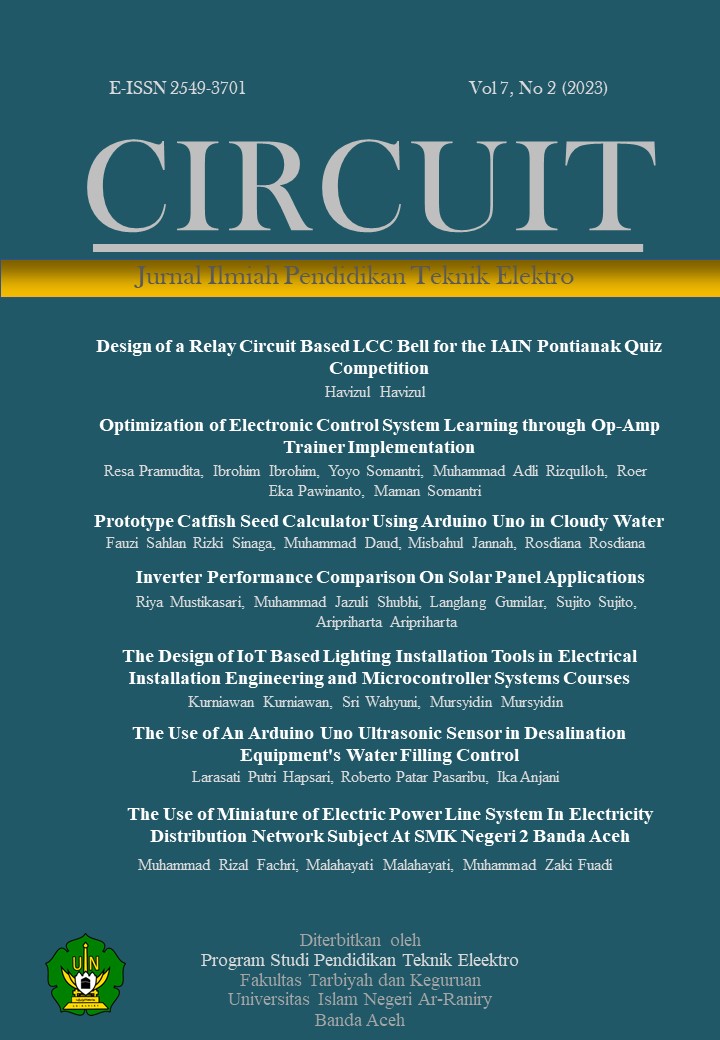Prototype Catfish Seed Calculator Using Arduino Uno in Cloudy Water
DOI:
https://doi.org/10.22373/crc.v7i2.16805Keywords:
Fish Seed Counter, Turbid Water, Proximity FC-51 sensorAbstract
Since Indonesia is an archipelagic nation, the economic sector of fisheries, particularly catfish farming, is one that has a lot of potential. However, a lot of catfish breeders still count their fish seeds by hand, which is time-consuming, particularly in hazy water conditions. Therefore, an automatic catfish seed counter is required in order to make calculations simpler, quicker, and more precise even under hazy water situations. In order to address these objectives, the prototype of a catfish seed counting device in murky water is shown in this study. This tool's prototype was created and constructed utilizing an Arduino Uno as the processor, two different types of sensors as inputs, and an LCD and buzzer as outputs. The FC-51 proximity sensor is used to count the quantity of fish seeds, while the turbidity module sensor measures the amount of turbidity in the water. With a total sample size of 50 fish fry, the test was run under three conditions for the turbidity level of the water samples: 6.21 NTU, 11.10 NTUs, and 16.38 NTU. According to the test results, the catfish seed counter in murky water performed admirably and was fairly accurate. An average error value of 3.2% is achieved with a water turbidity value of 6.21 NTU. An average error value of 6.8% was discovered at the turbidity value of 11.10 NTU. Finally, an average error value of 18.8% was discovered at a water turbidity value of 16.38 NTU. In order for this catfish seed counter to be effective, water turbidity values below 13 NTU with a minor error of 10% are preferred, particularly water turbidity values below 8 NTU with a little error of 5%.
References
Afiyat, N., & Rifqi, M. (2020). Rancang Bangun Alat Penghitung Benih Ikan Bandeng Gelondongan Berbasis Mikrokontroler Atmega 328. Simetris: Jurnal Teknik Mesin, Elektro Dan Ilmu Komputer, 11(1), 107–118. https://doi.org/10.24176/simet.v11i1.3725
Aldoni, F., & Mukhaiyar, R. (2022). Alat Penghitung Bibit Ikan Otomatis Berbasis Arduino. Ranah Research : Journal of Multidicsiplinary Research and Development, 4(2), 26–34.
Amri, C. F. Al. (2020). Rancang Bangun Fish Counter Untuk Menghitung Bibit Ikan Lele. In Skripsi Program Sarjana Teknik Elektro, Universitas Islam Indonesia.
Azahari, Arfyanti, I., & Yono, E. A. (2021). Alat Bantu Monitoring Debet Uang Nasabah di ATM Hyosung Bank BRI pada PT. Swadharma Sarana Informatika Berbasis Arduino. Informatika WICIDA, 10(2), 77–83. https://doi.org/10.46984/inf-wcd.1828
Dianovita, & Daud, M. (2016). Design and Realization Gas Control System in Closed Room Based on Fuzzy Logic. International Conference on Engineering and Science for Research and Development (ICESReD) Theory, 277–285.
Gunadi, & Daud, M. (2022). Rancang Bangun Sistem Kontrol Keasaman Air Kolam Ikan Menggunakan Sensor pH Berbasis Arduino. Jurnal Fokus Elektroda, 07(04), 248–254.
Irfan, A. (2018). Rancang Bangun Alat Penghitung Benih Ikan Mas Berbasis Mikrokontroler. Jurnal IT, 9(1), 22–26.
Irianto, I. K. (2015). Pengelolaan Air. Universitas Warmadewa.
Lestari, T. P., & Dewantoro, E. (2016). Pengaruh Suhu Media Pemeliharaan Terhadap Laju Pemangsaan dan Pertumbuhan Larva Ikan Lele Dumbo (Clarias gariepinus). Jurnal Ruaya, 6(1), 14–22.
Purbowaskito, W., & Handoyo, R. (2017). Perancangan Alat Penghitung Benih Ikan Berbasis Sensor Optik. Jurnal Rekayasa Mesin, 8(3), 141–148. https://doi.org/10.21776/ub.jrm.2017.008.03.4
Putra, F. A. (2017). Analisis Pengembangan Usaha Pembesaran Ikan Lele Sangkuriang (Clarias sp) di Desa Pintu Kecamatan Jenangan Ponorogo Jawa Timur. In Skripsi Program Sarjana Agrobisnis Perikanan Universitas Brawijaya.
Rimbawati, R., Cholish, C., Tanjung, W. A. L., & Effendy, M. A. R. (2021). Pengujian Air Bersih Menjadi Hidrogen Untuk Energi Alternatif Menggunakan Arduino. CIRCUIT: Jurnal Ilmiah Pendidikan Teknik Elektro, 5(1), 65–74. https://doi.org/10.22373/crc.v5i1.8276
Rosyady, P. A., Ikhsan, Z. A., & Feter, M. R. (2022). Prototype Lampu Lalu Lintas Adaptif Berdasarkan Panjang Antrian Kendaraan Berbasis Arduino Uno. CIRCUIT: Jurnal Ilmiah Pendidikan Teknik Elektro, 6(2), 173–186.
Subagyo, L. A., & Suprianto, B. (2017). Sistem Monitoring Arus Tidak Seimbang 3 Fasa Berbasis Arduino UNO. Jurnal Teknik Elektro, 6(3), 213–221.
Trianda, Didi., Wahyuni, Sri., Mursyidin. (2022). Penerapan Modul Praktikum Instalasi Motor Listrik di SMKN 1 Darul Kamal. Circuit: Jurnal Ilmiah Pendidikan Teknik Elektro, 6(2), p. 187-195
Wiguna, C. (2019). Rancang Bangun Alat Penghitung Bibit Ikan Lele Berbasis Digitalisasi dan Energi Surya sebagai Alternatif. In Tugas Akhir Program Diploma, Universitas Andalas. http://scholar.unand.ac.id/44758/
Yutanto, J., Sinulingga, E. P., & Fahmi, F. (2018). Rancangan Penghitung Benih Ikan Portable Berbasis Arduino. Talenta Conference Series: Energy and Engineering (EE), 1(1), 080–086. https://doi.org/10.32734/ee.v1i1.115
Downloads
Published
Issue
Section
License
Authors who publish in CIRCUIT: Jurnal Ilmiah Pendidikan Teknik Elektro agree to the following terms:
- Authors retain copyright and grant the journal right of first publication with the work licensed under a Creative Commons Attribution-ShareAlike 4.0 International License (CC BY-SA 4.0) that allows others to share and adapt the work with an acknowledgement of the authorship and initial publication in this journal
- Authors are able to enter into separate, additional contractual arrangements for the non-exclusive distribution of the journal's published version of the work (e.g., post it to an institutional repository or publish it in a book), with an acknowledgment of its initial publication in this journal.
- Authors are permitted and encouraged to post their work online (e.g., in institutional repositories or on their website) prior to and during the submission process, as it can lead to productive exchanges, as well as earlier and greater citation of published work. (See The Effect of Open Acces)

